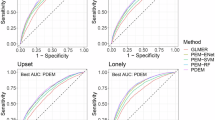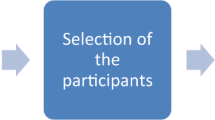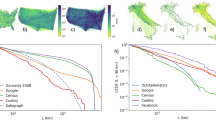Abstract
Mapping individual differences in behavior is fundamental to personalized neuroscience, but quantifying complex behavior in real world settings remains a challenge. While mobility patterns captured by smartphones have increasingly been linked to a range of psychiatric symptoms, existing research has not specifically examined whether individuals have person-specific mobility patterns. We collected over 3000 days of mobility data from a sample of 41 adolescents and young adults (age 17–30 years, 28 female) with affective instability. We extracted summary mobility metrics from GPS and accelerometer data and used their covariance structures to identify individuals and calculated the individual identification accuracy—i.e., their “footprint distinctiveness”. We found that statistical patterns of smartphone-based mobility features represented unique “footprints” that allow individual identification (p < 0.001). Critically, mobility footprints exhibited varying levels of person-specific distinctiveness (4–99%), which was associated with age and sex. Furthermore, reduced individual footprint distinctiveness was associated with instability in affect (p < 0.05) and circadian patterns (p < 0.05) as measured by environmental momentary assessment. Finally, brain functional connectivity, especially those in the somatomotor network, was linked to individual differences in mobility patterns (p < 0.05). Together, these results suggest that real-world mobility patterns may provide individual-specific signatures relevant for studies of development, sleep, and psychopathology.
Similar content being viewed by others
Log in or create a free account to read this content
Gain free access to this article, as well as selected content from this journal and more on nature.com
or
Code availability
The code for GPS data preprocessing, mobility metric extraction, individual identification, additional analysis, and data visualization is available in R on github: https://github.com/PennLINC/footprinting. Code notebook is available at: https://pennlinc.github.io/footprinting/.
References
Insel TR. Digital phenotyping: Technology for a new science of behavior. JAMA. 2017;318:1215–6.
Onnela JP. Opportunities and challenges in the collection and analysis of digital phenotyping data. Neuropsychopharmacology. 2021;46:45–54.
Fraccaro P, Beukenhorst A, Sperrin M, Harper S, Palmier-Claus J, Lewis S, et al. Digital biomarkers from geolocation data in bipolar disorder and schizophrenia: a systematic review. J Am Med Inform Assoc. 2019;26:1412–20.
Cote DJ, Barnett I, Onnela J-P, Smith TR. Digital Phenotyping in Patients with Spine Disease: A Novel Approach to Quantifying Mobility and Quality of Life. World Neurosurg. 2019;126:e241–e249.
Panda N, Solsky I, Huang EJ, Lipsitz S, Pradarelli JC, Delisle M, et al. Using Smartphones to Capture Novel Recovery Metrics After Cancer Surgery. JAMA Surg. 2020;155:123–9.
Tost H, Reichert M, Braun U, Reinhard I, Peters R, Lautenbach S, et al. Neural correlates of individual differences in affective benefit of real-life urban green space exposure. Nat Neurosci. 2019;22:1389–93.
Heller AS, Shi TC, Ezie CEC, Reneau TR, Baez LM, Gibbons CJ, et al. Association between real-world experiential diversity and positive affect relates to hippocampal–striatal functional connectivity. Nat Neurosci. 2020;23:800–4.
Finn ES, Shen X, Scheinost D, Rosenberg MD, Huang J, Chun MM, et al. Functional connectome fingerprinting: Identifying individuals based on patterns of brain connectivity HHS Public Access. Nat Neurosci. 2015;18:1664–71.
Horien C, Shen X, Scheinost D, Constable RT. The individual functional connectome is unique and stable over months to years. Neuroimage. 2019;189:676–87.
Miranda-Dominguez O, Mills BD, Carpenter SD, Grant KA, Kroenke CD, Nigg JT, et al. Connectotyping: Model Based Fingerprinting of the Functional Connectome ((S. Hayasaka, editor)). PLoS One. 2014;9:e111048.
Kaufmann T, Alnæs D, Doan NT, Brandt CL, Andreassen OA, Westlye LT. Delayed stabilization and individualization in connectome development are related to psychiatric disorders. Nat Neurosci. 2017;20:513–5.
González MC, Hidalgo CA, Barabási AL. Understanding individual human mobility patterns. Nature. 2008;453:779–82.
Koenigsberg HW, Harvey PD, Mitropoulou V, Schmeidler J, New AS, Goodman M, et al. Characterizing affective instability in borderline personality disorder. Am J Psychiatry. 2002;159:784–8.
Tragesser SL, Solhan M, Schwartz-Mette R, Trull TJ. The Role of Affective Instability and Impulsivity in Predicting Future BPD Features. J Pers Disord. 2007;21:603–14.
Calkins ME, Moore TM, Satterthwaite TD, Wolf DH, Turetsky BI, Roalf DR, et al. Persistence of psychosis spectrum symptoms in the Philadelphia Neurodevelopmental Cohort: a prospective two-year follow-up. World Psychiatry. 2017;16:62–76.
Torous J, Kiang MV, Lorme J, Onnela J-P. New Tools for New Research in Psychiatry: A Scalable and Customizable Platform to Empower Data Driven Smartphone. Res JMIR Ment Heal. 2016;3:e16.
Barnett I, Onnela J-P. Inferring mobility measures from GPS traces with missing data. Biostatistics. 2018;21:e98–e112.
Andridge RR, Little RJA. A Review of Hot Deck Imputation for Survey Non-response. Int Stat Rev. 2010;78:40–64.
Vega J, Li M, Aguillera K, Goel N, Joshi E, Durica KC, et al. (n.d.): RAPIDS: Reproducible Analysis Pipeline for Data Streams Collected with Mobile Devices. https://doi.org/10.2196/preprints.23246
Shaffer F, Ginsberg JP. An Overview of Heart Rate Variability Metrics and Norms. Front Public Heal. 2017;5:258.
Gratton C, Laumann TO, Nielsen AN, Greene DJ, Gordon EM, Gilmore AW, et al. Functional Brain Networks Are Dominated by Stable Group and Individual Factors, Not Cognitive or Daily Variation. Neuron. 2018;98:439–452.e5.
Kiang M V, Chen JT, Krieger N, Buckee CO, Alexander MJ, Baker JT, et al. (2021): Sociodemographic Characteristics of Missing Data in Digital Phenotyping. medRxiv 2020.12.29.20249002.
Shiffman S, Stone AA, Hufford MR. Ecological Momentary Assessment. Annu Rev Clin Psychol. 2008;4:1–32.
Trull TJ, Solhan MB, Tragesser SL, Jahng S, Wood PK, Piasecki TM, et al. Affective instability: measuring a core feature of borderline personality disorder with ecological momentary assessment. J Abnorm Psychol. 2008;117:647–61.
Jahng S, Wood PK, Trull TJ. Analysis of affective instability in ecological momentary assessment: Indices using successive difference and group comparison via multilevel modeling. Psychol Methods. 2008;13:354–75.
Wood SN. Fast stable restricted maximum likelihood and marginal likelihood estimation of semiparametric generalized linear models. J R Stat Soc Ser B (Statistical Methodol. 2011;73:3–36.
Wood SN. Stable and Efficient Multiple Smoothing Parameter Estimation for Generalized Additive Models. J Am Stat Assoc. 2004;99:673–86.
Jirsaraie RJ, Kaczkurkin AN, Rush S, Piiwia K, Adebimpe A, Bassett DS, et al. Accelerated cortical thinning within structural brain networks is associated with irritability in youth. Neuropsychopharmacology. 2019;44:2254–62.
Esteban O, Markiewicz CJ, Blair RW, Moodie CA, Isik AI, Erramuzpe A, et al. fMRIPrep: a robust preprocessing pipeline for functional MRI. Nat Methods. 2019;16:111–6.
Gorgolewski K, Burns CD, Madison C, Clark D, Halchenko YO, Waskom ML, et al. Nipype: A Flexible, Lightweight and Extensible Neuroimaging Data Processing Framework in Python. Front Neuroinform. 2011;5:13.
Ćirić R, Adebimpe A, Cieslak M, Rosen A, sattertt, Tooley U, et al. (2020): PennBBL/xcpEngine: atlas in MNI2009. https://doi.org/10.5281/ZENODO.4010846
Ciric R, Rosen AFG, Erus G, Cieslak M, Adebimpe A, Cook PA, et al. Mitigating head motion artifact in functional connectivity MRI. Nat Protoc. 2018;13:2801–26.
Tustison NJ, Avants BB, Cook PA, Zheng Y, Egan A, Yushkevich PA, et al. N4ITK: improved N3 bias correction. IEEE Trans Med Imaging. 2010;29:1310–20.
Avants BB, Epstein CL, Grossman M, Gee JC. Symmetric diffeomorphic image registration with cross-correlation: evaluating automated labeling of elderly and neurodegenerative brain. Med Image Anal. 2008;12:26–41.
Jenkinson M, Bannister P, Brady M, Smith S (n.d.): Improved Optimization for the Robust and Accurate Linear Registration and Motion Correction of Brain Images. https://doi.org/10.1006/nimg.2002.1132
Cox RW. AFNI: software for analysis and visualization of functional magnetic resonance neuroimages. Comput Biomed Res. 1996;29:162–73.
Glasser MF, Sotiropoulos SN, Wilson JA, Coalson TS, Fischl B, Andersson JL, et al. The minimal preprocessing pipelines for the Human Connectome Project. Neuroimage. 2013;80:105–24.
Greve DN, Fischl B. Accurate and robust brain image alignment using boundary-based registration. Neuroimage. 2009;48:63–72.
Ciric R, Wolf DH, Power JD, Roalf DR, Baum GL, Ruparel K, et al. Benchmarking of participant-level confound regression strategies for the control of motion artifact in studies of functional connectivity. Neuroimage. 2017;154:174–87.
Hallquist MN, Hwang K, Luna B. The nuisance of nuisance regression: Spectral misspecification in a common approach to resting-state fMRI preprocessing reintroduces noise and obscures functional connectivity. Neuroimage. 2013;82:208–25.
Schaefer A, Kong R, Gordon EM, Laumann TO, Zuo X-N, Holmes AJ, et al. Local-Global Parcellation of the Human Cerebral Cortex from Intrinsic Functional Connectivity MRI. Cereb Cortex. 2018;28:3095–114.
Yeo BTT, Krienen FM, Sepulcre J, Sabuncu MR, Lashkari D, Hollinshead M, et al. The organization of the human cerebral cortex estimated by intrinsic functional connectivity. J Neurophysiol. 2011;106:1125–65.
Xia CH, Ma Z, Cui Z, Bzdok D, Thirion B, Bassett DS, et al. Multi‐scale network regression for brain‐phenotype associations. Hum Brain Mapp. 2020;41:2553–66.
APA (2013): Diagnostic and Statistical Manual of Mental Disorders, 5th ed. Arlington, VA: American Psychiatric Publishing.
Yen S, Shea MT, Sanislow CA, Grilo CM, Skodol AE, Gunderson JG, et al. Borderline Personality Disorder Criteria Associated With Prospectively Observed Suicidal Behavior. Am J Psychiatry. 2004;161:1296–8.
Ebner-Priemer UW, Trull TJ. Ecological momentary assessment of mood disorders and mood dysregulation. Psychol Assess. 2009;21:463–75.
Harvey AG. Sleep and Circadian Rhythms in Bipolar Disorder: Seeking Synchrony, Harmony, and Regulation. Am J Psychiatry. 2008;165:820–9.
Elliott ML, Knodt AR, Cooke M, Kim MJ, Melzer TR, Keenan R, et al. General functional connectivity: Shared features of resting-state and task fMRI drive reliable and heritable individual differences in functional brain networks. Neuroimage. 2019;189:516–32.
Onnela J-P, Rauch SL. Harnessing Smartphone-Based Digital Phenotyping to Enhance Behavioral and Mental Health. Neuropsychopharmacology. 2016;41:1691–6.
Sobin C, Sackeim H. Psychomotor symptoms of depression. Am J Psychiatry. 1997;154:4–17.
Reich DB, Zanarini MC, Fitzmaurice G. Affective lability in bipolar disorder and borderline personality disorder. Compr Psychiatry. 2012;53:230–7.
Davidson RJ. One of a kind: the neurobiology of individuality. Cerebrum. 2014;2014:8.
Davidson RJ, McEwen BS. Social influences on neuroplasticity: stress and interventions to promote well-being. Nat Neurosci. 2012;15:689–95.
Broome MR, He Z, Iftikhar M, Eyden J, Marwaha S. Neurobiological and behavioural studies of affective instability in clinical populations: A systematic review. Neurosci Biobehav Rev. 2015;51:243–54.
Pines AR, Larsen B, Cui Z, Sydnor VJ, Bertolero MA, Adebimpe A, et al. (2021): Dissociable Multi-scale Patterns of Development in Personalized Brain Networks. bioRxiv 2021.07.07.451458.
Power JD, Fair DA, Schlaggar BL, Petersen SE. The Development of Human Functional Brain Networks. Neuron. 2010;67:735–48.
Newbold DJ, Laumann TO, Hoyt CR, Hampton JM, Montez DF, Raut RV, et al. Plasticity and Spontaneous Activity Pulses in Disused Human Brain Circuits. Neuron. 2020;107:580–589.e6.
Schulze L, Domes G, Krüger A, Berger C, Fleischer M, Prehn K, et al. Neuronal correlates of cognitive reappraisal in borderline patients with affective instability. Biol Psychiatry. 2011;69:564–73.
Faurholt-Jepsen M, Busk J, Frost M, Vinberg M, Christensen EM, Winther O, et al. Voice analysis as an objective state marker in bipolar disorder. Transl Psychiatry. 2016;6:e856.
Boers E, Afzali MH, Conrod P. Temporal Associations of Screen Time and Anxiety Symptoms Among Adolescents. Can J Psychiatry. 2020;65:206–8.
Funding
This study was supported by the AE foundation, a Young Investigator Grant from the Brain & Behavior Research Foundation, as well as grants from National Institute of Health: R01MH107703, R01MH112847, R01MH113550, R37MH125829, R01EB022573, R01MH120482, RF1MH116920, R01MH116884, Intramural Research Program, and K01DA047417. The content is solely the responsibility of the authors and does not necessarily represent the official views of any of the funding agencies.
Author information
Authors and Affiliations
Contributions
CHX, IB, and TDS made substantial contributions to the conception or design of the work; CHX, IB, TMT, AA, JTB, DSB, MAB, MEC, ZC, EL, SL, DML, MLM, TMM, KM, KP, AP, DRR, SRG, DHW, LHU and TDS contributed substantially to the acquisition, analysis, or interpretation of data for the work. All authors contributed to drafting the work, revising it critically for important intellectual content, and gave final approval of the version to be published. All authors agreed to be accountable for all aspects of the work in ensuring that questions related to the accuracy or integrity of any part of the work are appropriately investigated and resolved.
Corresponding author
Ethics declarations
Competing interests
DHW currently serves as an Editorial Board Member for Neuropsychopharmacology. The other authors have no conflict of interest to disclose.
Additional information
Publisher’s note Springer Nature remains neutral with regard to jurisdictional claims in published maps and institutional affiliations.
Supplementary information
Rights and permissions
About this article
Cite this article
Xia, C.H., Barnett, I., Tapera, T.M. et al. Mobile footprinting: linking individual distinctiveness in mobility patterns to mood, sleep, and brain functional connectivity. Neuropsychopharmacol. 47, 1662–1671 (2022). https://doi.org/10.1038/s41386-022-01351-z
Received:
Revised:
Accepted:
Published:
Issue date:
DOI: https://doi.org/10.1038/s41386-022-01351-z
This article is cited by
-
Closing the loop in psychiatric deep brain stimulation: physiology, psychometrics, and plasticity
Neuropsychopharmacology (2024)



